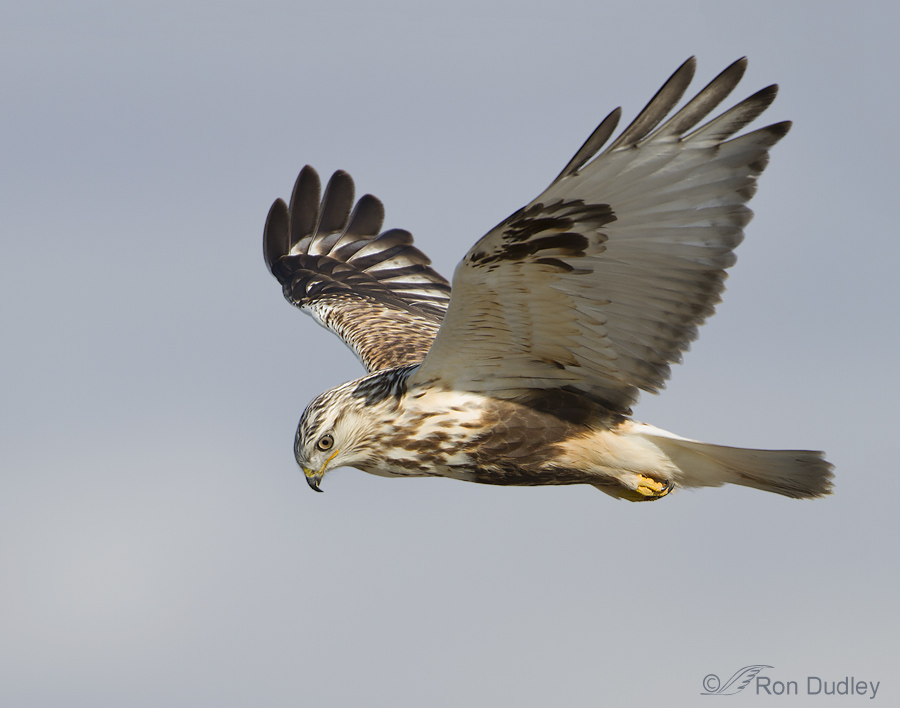Like some other buteos, depending on conditions the Rough-legged Hawk may hunt from the air using flapping/gliding flight or from an elevated perch but their tendency to hunt in flight goes up significantly with increasing wind speed. This makes sense because hovering in the wind requires less energy than flapping flight.
This bird was hunting voles along the causeway to Antelope Island when the wind velocity and direction was just right to often give me an almost stationary subject as it hovered in the air and scanned the elevated shoreline for voles. I even had a good light angle – that’s a combination that doesn’t happen very often with me.
1/1600, f/6.3 ISO 500, 500 f/4, 1.4 tc, not baited, set up or called in, canvas added for composition
Interestingly, there’s some evidence to indicate that this species detects and identifies vole urine and feces from the air and then concentrates its hunting in areas of high prey density. I don’t know if that was happening here but while I was with this bird it captured several voles and even consumed one of them in flight. Usually this species flies to a nearby perch to eat its meal but there are few perches available along this part of the causeway and the vole was a small one so it was easier to swallow.
I’ve cropped fairly tightly on this hawk, which I often do with plain sky backgrounds. There’s a vertical color gradient in the background blues but it’s not pronounced enough to be particularly interesting. I think the nice detail on the bird at this close range makes up for it.
Ron



I wonder why why,if “birds who live in colder parts of the world have legs that are feathered to their toes”, Bald Eagles do not. They wear short pants or knickers…their feathers do not go down to their feet like those of the Golden Eagles…yet it is the Bald, not the Goldens you see in Alaska where it can get coldernell…..????
When you compare those two species of eagles you are talking about one that gets much of its food from water (not great to get wet feathers in very cold temp.). That species actually doesn’t reside in the coldest regions of Alaska but rather were the temp. are warm enough to keep the water open. While the Golden (a Booted eagle rather than Fish or Sea eagle) often resides at altitude in the mountains, generally, as a breeder in most parts of it’s world. Basically holarctic but migrant.
Bill
gorgeous!
It is a lovely photo of a beautiful subject!
Oh wow. Such an incredible shot. The voles should start waving their white flags now.
I am SOOOOngreatful not to be a vole!
Yup, me too, Patty.
Love the feather detail! This is an amazing shot.
Thank you, Susan.
Great shot to show the feathered legs from whence they get their name. You don’t always see those fuzzy leggings in a perched bird. Thanks, Ron. These are one of my favorites.
I noticed that too, Louise. If I remember correctly, their species name “lagopus” means “hare foot”. Can’t quite figure that out though…
Ron: “lagopus” is often used to refer to animals that have the capability of dealing with very cold temperatures. Rough-legged’s along with Golden’s, Ferruginous, and our NA owls are all feathered over their feet to their toes. All that aids in dealing with cold (and some bites from prey).
The topic of hovering might be suitable for a good discussion. Some authorities claim hovering is not possible by lager birds. Perhaps this is semantics as a few new terms have evolved to describe different bird flight.
Bill
What a wonderful shot and very interesting comment! Thanks for sharing Ron!
Glad you liked it, Charlotte.
What a beautiful photo! Thanks…
Thanks, Alison.
Wow! Amazingly sharp, detailed, clear shot.. so cool to look at, thank you!
When are you going to put all this together for a spectacular book? 🙂
Thanks, Bill. Don’t think that’s going to happen – too much work!
Ron, again thanks for a great photo of feather groupings. Had to get out my Nick Fox Bird of Prey to help identify them. Also glad William Dove got me started again with his comments on your recent sequence of the hunting harrier. Your concentration getting these shots is only matched by that of the hunting bird.
Thanks, Diana. And I agree, Bill has been enormously helpful and generous of his time and knowledge with us.
Diana: Nick’s book is one of the best out there regarding raptors. Sadly it’s no longer in print, although I am encouraging the publisher, David Hancock, a friend for the need to produce another publishing.
Bill